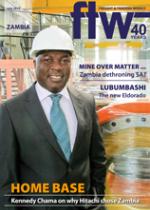Talk on the Zambian
Copperbelt quickly turns to
the opportunities just over
Kafue River which forms
the border between Zambia and
the Democratic Republic of Congo
(DRC).
The capital of the Katanga
province and second-largest city in
the DRC is the new El Dorado of
central Africa. Like the legendary
city of El Dorado, it has gold.
But, there is much more. Best
known for the copper mines, the
area also produces cobalt (with
half the world’s known reserves),
diamonds, zinc and manganese.
It has estimated
reserves of five
million tons
of cobalt, and
6 m tons of
zinc. The 70 m
tons of copper
reserves put the
region behind
Chile, which has
reserves of 88 m
tons. However,
the DRC's
deposits are of
superior quality,
yielding an average 3.5% copper
compared with Chile's 0.5%.
All of which make for rich
pickings for both miners and
logistics suppliers, without which no
industry can survive.
The DRC is seen as the next
big opportunity in Africa for the
logistics industry, with the initial
focus being on the pot of gold that is
most accessible from Zambia.
Lubumbashi
has undergone a
demographic and
economic transformation over the
last 10 years, with a doubling of
population to around 1.5 million.
By 2020, the city’s population will
double to more than 5m, according
to the United Nations. The growth
is supported by diversification of the
economy.
Manufactures include textiles,
food products
and beverages,
printing, bricks,
and copper
smelting. The city
is home to the
Simba brewery,
which produces
Tembo beer. It is
served by a daily
newspaper.
Lubumbashi
also hosts the
headquarters
of one of the
country's largest
banks, Trust Merchant Bank.
Korongo Airlines, a joint-venture
between Brussels Airlines and
the multinational Groupe George
Forrest International Afrique, has
its head office in Lubumbashi. The
airline introduced a Johannesburg-
Lubumbashi service in April 2012.
Some of the larger mining
companies in
the area include
Anvil Mining
Congo
SARL,
First Quantum Minerals,
Kababankola Mining Company,
Tenke Fungurume, Ruashi Mining,
Somika, Freeport-McMoRan
Copper & Gold and Glencore
International.
The city’s rapidly growing
population needs to be housed and
fed. But, in contrast to many other
cities in the region, Lubumbashi
is growing its own rather than
importing all its requirements.
A Food and Agriculture
Organisation (FAO) project has
created a flourishing urban and periurban
horticulture (UPH) sector.
The area under horticulture has
risen from less than 100 hectares to
725 ha. Market gardens ringing the
city produce more than 60 000 tons
of vegetables a year.
This still creates business for the
logistics supply chain as fertilisers
and farming equipment is mostly
imported, and must of necessity
travel through Zambia.
Rapid growth and urbanisation
come at a cost in terms of stability.
In April this year the city was
invaded by Mai-Mai Bakata Katanga
secessionists, followed by fighting
which left 35 dead. South African
troops are part of the United Nations
peacekeeping force in the eastern
Goma province.
The city of Goma is around
1600 km from Lubumbashi.
No one said life would be easy in
El Dorado.
The DRC is currently ranked 181st
out of 185 countries on the World
Bank’s Ease of Doing Business index.
Zambia is ranked 74th.
Logistics providers are opting to
retain their base in Zambia. Mines
are also storing chemicals and other
supplies in Zambia – which has
created a demand for warehousing
on the Copperbelt and as far south as
Walvis Bay.
INSERT
The DRC is seen as the next
big opportunity in Africa
for the logistics industry,
with the initial focus being
on the pot of gold which
is most accessible from
Zambia.
CAPTION
Hakuna Matata (No worries): The banner on the back of this Congolese truck
making its way through Ndola says it all.

